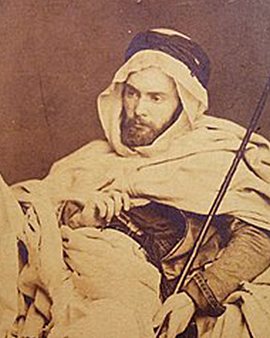The art world has produced many remarkable figures, but few artists have a story as fascinating and adventurous as that of Gustave Achille Guillaumet. Born on March 26, 1840, in Puteaux, a picturesque commune near Paris, Guillaumet entered the art world spotlight with an expressive palette and a distinctive style that manifested itself most notably in his striking depictions of North Africa. His works, now accessible in the form of exquisite fine art prints, provide a fascinating glimpse into the scenic beauty and culture of North Africa. Gustave Guillaumet began his artistic training with the renowned artists Francois Edouard Picot and Félix Joseph Barrias before studying at the École nationale supérieure des Beaux-Arts in Paris in 1857 under the direction of Alexandre Denis Abel de Pujol. His artistic journey took him on an adventurous journey as he sought the prestigious Prix de Rome scholarship in 1861. Although he was denied victory, a new door opened that led him across the Mediterranean to Algeria. There, he spent three months in the military hospital in Biskra due to a bout of malaria.
However, this ordeal did not prevent Guillaumet from visiting Algeria ten times between 1861 and 1867. The harsh beauty of the desert and the simple lives of the locals inspired many of his most fascinating works. Unlike many of his contemporaries who adhered to Orientalism and portrayed North Africa in an idealized or anecdotal light, Guillaumet's work was characterized by a realistic depiction of the harsh desert landscape and hard life. His painting "The Sahara" was first exhibited to great acclaim at the Salon of 1868. Guillaumet's masterpiece "The Sahara", depicting a scene of harsh survival in the desert, is reproduced today as an art print of the highest quality. This carefully crafted print offers an opportunity to explore the stunning details and profound meaning of this stunning painting. From 1879 to 1884, La Nouvelle Revue published a collection of Algerian scenes compiled by Guillaumet. These were later published as a book under the title Tableaux Algériens. It contains twelve etchings by various artists and 128 relief prints based on sketches and drawings by Guillaumet himself. For his extraordinary artistic talent and contribution to the art world, Guillaumet was made a Knight of the Legion of Honor, France's highest honor, in 1878.
Guillaumet's eventful life came to an abrupt end in 1887. His sudden death under tragic circumstances cast a shadow over his impressive life's work. Speculation about his death made the rounds, but it was undisputed that the art world had lost one of its most distinctive figures. Today, a sculpture by Louis Ernest Barrias on his grave in Montmartre Cemetery commemorates Gustave Guillaumet's unique life and artistic achievements. The exquisite art prints, based on Guillaumet's original works, offer art lovers the opportunity to appreciate his remarkable works and bring his artistic vision to life in their own spaces. They are not only a tribute to the legacy of this extraordinary artist, but also a testament to the timeless beauty and unique charm of his art.
×





.jpg)
.jpg)
_-_(MeisterDrucke-1659707).jpg)
_-_(MeisterDrucke-1659707).jpg)
_-_(MeisterDrucke-1659771).jpg)
_-_(MeisterDrucke-1659771).jpg)
_Une_femme_et_-_(MeisterDrucke-1324951).jpg)
_Une_femme_et_-_(MeisterDrucke-1324951).jpg)
.jpg)
.jpg)
.jpg)
.jpg)
.jpg)
.jpg)
.jpg)
.jpg)
.jpg)
.jpg)
.jpg)
.jpg)
.jpg)
.jpg)
.jpg)
.jpg)
_-_(MeisterDrucke-970017).jpg)
_-_(MeisterDrucke-970017).jpg)
_-_(MeisterDrucke-1030596).jpg)
_-_(MeisterDrucke-1030596).jpg)
.jpg)
.jpg)
_-_(MeisterDrucke-1471728).jpg)
_-_(MeisterDrucke-1471728).jpg)
_cm_75x49_Mand_-_(MeisterDrucke-1419083).jpg)
_cm_75x49_Mand_-_(MeisterDrucke-1419083).jpg)






